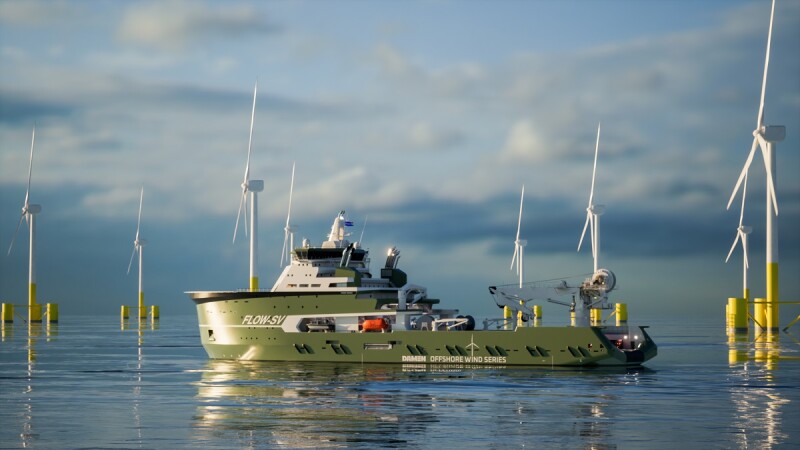Damen has developed the FLOW-SV vessel concept that can accelerate the development of floating windfarm installation, the company said. The Damen 492'x105' (150 meters by 32-meters) FLOW-SV is specially designed to install ground tackles for offshore turbine floaters.
The vessel can load the immense lengths of chain needed to install and secure nine anchors or suction piles, Damen said. Instead of mooring one floating windmill in a mission, three can be secured. It also applies sufficient proof loading on the anchors to make the installation more efficient, company officials said.
“With the FLOW-SV, we have developed a vessel which covers the entire process of attaching mooring lines," Wijtze van der Leij, sales manager, said in a statement. "This vessel, combining the supply, installation, securing and inspection of the ground tackles for floating turbines in one vessel, introduces a big step forward towards large scale installation of floating windfarms. The concept reflects our expertise in operational demands and efficiency. At the moment, we are still in the concept phase. But we are now entering a stage where we would like to partner up to refine and customize this concept. Together with a launching customer, we aspire to accelerate the floating offshore windfarm installation industry.”
The size and weight of anchors and chains needed for installing offshore floating wind turbines are so big that a larger vessel is needed than existing anchor handling vessels. As the FLOW-SV will be able to take all the materials and equipment needed to install three floaters, the vessel is designed to save time on transits and loading. Secured at all three corners, a floater needs three ground tackles.
When Damen engineers defined the amounts of gear that the FLOW-SV needs to take onboard to be able to install three floaters in a base case of 328' water depth, their calculations added up to five kilometers (3.1 miles) of chain (chain links of 152-mm diameter) 4.5 kilometers (2.79) fiber rope of 112-mm diameter, nine anchors each weighing 15 tons and almost 100 clump weights of 10 tons each, D-shackles, tensioners, as well as steel cable.
Getting the gear to the place of operation means the vessel carries a load in excess of 4,000 tons. Depending on seabed conditions, depth and windfarm operator requirements, anchors can be replaced with suction piles to provide a secure ground tackle.
When deploying the anchors at sea, the chain is guided to large winches on the forward end of the large open aft deck, from where it leads over the deck to the stern where it is deployed into the water. A 250-ton crane (at 12.5 m reach) with active heave compensation is installed along the aft deck's starboard side while two smaller cargo rail cranes are available for handling gear on deck. A triple drum anchor winch can deploy 600 tons pulling force.
A unique feature of the FLOW-SV is the combination of bollard pull generated by the thrusters and added pulling force from the bow reaction anchor winch. This adds up to 1,000 tons of proof load. The FLOW-SV deploys the bow anchor and embeds it by reversed bollard pull. The boat then moves to the spot where the anchor for the floater needs to be installed. After letting out enough chain length, the anchor for the floater needs to be proof loaded, ensuring a secure seabed connection. Using the four thrusters, FLOW-SV has 400 tons of bollard pull. Pulling strength is enhanced by the forward anchor handling winch, that generates another 600 tons. At that moment, approximately 1,000 tons of proof-load is acting on the turbine floater anchor.
Two fixed propellers in nozzles and two azimuthing thrusters at the stern propel the FLOW-SV and provide forward bollard pull. These propellers in nozzles turn 180° to provide ample reverse bollard pull when the bow anchor is set. The azimuthing thrusters are also engaged for dynamic positioning, together with the retractable azimuthing thruster and tunnel thrusters in the bow section of the vessel.
Sea bottom inspection is needed to determine the best spot to install the anchor. FLOW-SV has two working class ROVs (remote operated vehicle) with two separate control rooms next to a moonpool (an opening to launch submarine vehicles in the middle of the vessel). After installing the anchors for the turbine floater, the ROVs can be deployed through the moonpool for inspection of the anchor and to see if it has dug in to provide secure ground connection.
In line with the purpose of installing renewable energy supply, the FLOW-SV is laid out for using the renewable fuel methanol. Tanks and piping are in place according to safety regulations for this future fuel. Six generators feed the electric thrusters. When the floater anchors are being secured and maximum bollard pull is required, the two fixed 5.5 meters (18') propellers in nozzles are engaged. At transit journeys between harbors and windfarm sites, the azimuthing 4.5-meter (14.76') propeller size thrusters propel the vessel. This eliminates the need for rudders. All propulsion units are positioned to have the least possible interference with anchor chains.




